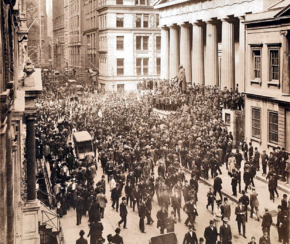
The Panic of 1907, also known as the 1907 Bankers' Panic or Knickerbocker Crisis,[1] was a financial crisis that took place in the United States over a three-week period starting in mid-October, when the New York Stock Exchange suddenly fell almost 50% from its peak the previous year. The panic occurred during a time of economic recession, and there were numerous runs affecting banks and trust companies. The 1907 panic eventually spread throughout the nation when many state and local banks and businesses entered bankruptcy. The primary causes of the run included a retraction of market liquidity by a number of New York City banks and a loss of confidence among depositors, exacerbated by unregulated side bets at bucket shops.[2]
The panic was triggered by the failed attempt in October 1907 to corner the market on stock of the United Copper Company. When the bid failed, banks that had lent money to the cornering scheme suffered runs that later spread to affiliated banks and trusts, leading a week later to the downfall of the Knickerbocker Trust Company, New York City's third-largest trust. The collapse of the Knickerbocker spread fear throughout the city's trusts as regional banks withdrew reserves from New York City banks. The panic then extended across the nation as vast numbers of people withdrew deposits from their regional banks, causing the 8th-largest decline in U.S. stock market history.[3]
The panic might have deepened if not for the intervention of financier J. P. Morgan,[4] who pledged large sums of his own money and convinced other New York bankers to do the same to shore up the banking system. That highlighted the limitations of the US Independent Treasury system, which managed the nation's money supply but was unable to inject sufficient liquidity back into the market. By November, the financial contagion had largely ended, only to be replaced by a further crisis due to the heavy borrowing of a large brokerage firm using the stock of Tennessee Coal, Iron and Railroad Company (TC&I) as collateral. Collapse of TC&I's stock price was averted by an emergency takeover by Morgan's U.S. Steel Corporation, a move approved by the trust-busting President Theodore Roosevelt. The following year, Senator Nelson W. Aldrich, a leading Republican, established and chaired a commission to investigate the crisis and propose future solutions, which led to the creation of the Federal Reserve System.[5][6]
- ^ "AMERICAN BANKS "IN THE JUNGLE"". The Advertiser. Adelaide. March 16, 1933. p. 8. Retrieved November 22, 2012 – via National Library of Australia.
- ^ Yale M. Braunstein, "The Role of Information Failures in the Financial Meltdown" Archived December 22, 2009, at the Wayback Machine, School of Information, UC Berkeley, Summer 2009
- ^ "What Prior Market Crashes Can Teach Us About Navigating the Current One". Morningstar, Inc. Retrieved June 25, 2020.
- ^ Panic of 1907: J.P. Morgan Saves the Day
- ^ Born of a Panic: Forming the Fed System
- ^ Tucker, Abigail (October 9, 2008). "The Financial Panic of 1907: Running from History". Smithsonian Magazine. Retrieved September 27, 2017.